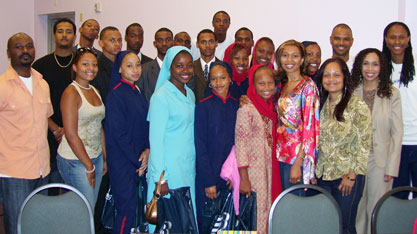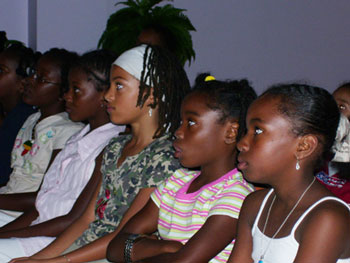Domestic violence, a raging epidemic
By Charlene Muhammad -National Correspondent- | Last updated: Sep 6, 2006 - 7:44:00 PMWhat's your opinion on this article?

AmASSI Health and Cultural Center's Adrianne Sears (4th from right) pose with rap session panelists and youth participants from Muhammad's Mosque No. 27.
|
The CDC recently reported in Morbidity and Mortality Weekly Report that one in 11 adolescents reports being a victim of physical dating violence, and that adolescents who report experiencing dating violence are also more likely to report binge drinking, suicide attempts, physical fighting, current sexual activity and unhealthy dieting behaviors.
The document, “Physical Dating Violence Among High School Students, United States, 2003” was based on an 18-month study of physical dating violence (PDV) among 14,956 students. It defined dating violence as physical, sexual or psychological violence within a dating relationship, and found that prevalence of reported PDV victimization was greater among Blacks (13.9 percent) than Whites (seven percent) and Latinos (9.5 percent).
The AmASSI Health and Cultural Center hosted approximately 150 youth—elementary students, pre-teens, teenagers and young adults—at the FAME Renaissance Center Aug. 10 for a first of three rap sessions to promote awareness about domestic violence among youth. It is part of Choose Respect, a CDC initiative designed to teach youth ages 11 to 14 about teen dating abuse and forming healthy relationships. The event featured a panel discussion and question-and-answer session, video screenings with the voices of domestic abusers and victims, and a collage of negative and degrading music videos followed by youth commentaries on the impact of music and media in domestic violence.
Michael Muhammad insisted that people reflect the images they put before the world, and that responsible art must take precedence, because people mimic what they see in media, even if it is to their own detriment.
Monique said she saw abuse growing up, which bore heavily on how she viewed her personal relationships, but through spiritual guidance and self-determination, she broke away from her abuser. Joseph highlighted the oft-unspoken role that women and girls play in domestic abuse incidents.

Young girls from the KRST Unity Center pay close attention to a music video presentation at the AmASSI Health and Cultural Center's Choose Respect Rap Session on Aug. 10. Photos: Charlene Muhammad
|
D’ondre Whitfield, an actor and panelist, urged, “Once you feel uncomfortable in a situation, it is OK for you to step away from that situation, however you need to do that.”
Mya, a high school student, stated, “Some people believe that if their boyfriend or spouse or whatever doesn’t become physical with you, then they don’t love you. But if they do become physical with you, that’s when you know that they don’t because they don’t have enough sense to know that you’re not going to like that.”
For Melissa, who attended with her mother and younger brother, the rap session may prove to be a lifesaver. “My older sister is in a similar situation with a very violent boyfriend. This taught me what I could do to try to help her out because she is in great danger, physically, mentally, everything,” the 15-year-old shared.
Adrianne Sears, who coordinated the event, offered a first start for youth to incorporate the concept of respect in practical ways into their daily lives. “First, you have to respect yourselves. That means the way we dress. We don’t wear shorts that barely cover our assets,” she said. “People take you for what they see. You could have a good heart, but if you’re dressed like a video person, that’s how people are going to perceive you.”
Western Regional Minister Tony Muhammad escorted approximately 20 youth from the Nation of Islam to the event.
“This is a great first step to deal with a social ill, a serious problem occurring within our community. The way teens relate to each other grows out of a culture now called hip hop. Many times the stereotypes that young people see is what they emulate every day,” he stated. “This must be taken on city and statewide tours, spending more time engaging the youth.”
But these grave statistics are not limited to the borders of the state of California; the increase in violence among youth has taken on national implications. According to the Indiana Coalition Against Domestic Violence (ICADV), July 1, 2004 to June 30, 2005 saw 81 total domestic violence deaths and there were over 4,000 adults and children served in Indiana Domestic Violence Shelters.
In April, students at Indiana University Kokomo raised $7,000 for domestic violence programs by spearheading the 3rd Annual Angel Walk and continued their efforts at awareness and resources throughout the academic year.
“They had the Criminal Justice Association compile literature on where to go for help. Latino students translated that literature into Spanish, and they also procured a 20-minute promotional video. They tutor children at domestic violence shelters and refurbished a playroom,” informed Anne-Marie Damler, director of communications and marketing at Indiana University Kokomo.
According to the Detroit News, 87 percent of homicides in Macomb County last year stemmed from domestic violence. Thus, 40 recommendations to reduce domestic violence attacks followed an 18-month study of five fatal and near-fatal incidents into the county. The recommendations included coordinated, countywide training for police, supervised visitation centers for parents to transfer children in safe settings, and training judges to recognize lethality indicators and respond accordingly when issuing personal protection orders.
- The Causes of Domestic Violence (FCN, Minister Farrakhan, 02-02-2011)
INSIDE STORIES AND REVIEWS
-
-
About Harriett ... and the Negro Hollywood Road Show
By Rabiah Muhammad, Guest Columnist » Full Story -
Skepticism greets Jay-Z, NFL talk of inspiring change
By Bryan 18X Crawford and Richard B. Muhammad The Final Call Newspaper @TheFinalCall » Full Story -
The painful problem of Black girls and suicide
By Charlene Muhammad -National Correspondent- » Full Story -
Exploitation of Innocence - Report: Perceptions, policies hurting Black girls
By Charlene Muhammad -National Correspondent- » Full Story -
Big Ballin: Big ideas fuel a father’s Big Baller Brand and brash business sense
By Bryan Crawford -Contributing Writer- » Full Story






 Click Here Stay Connected!
Click Here Stay Connected!








